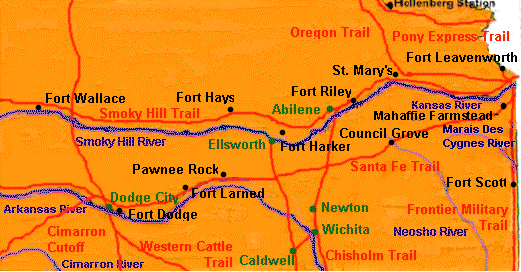Early Statehood: 1842 - 1865
- Historic Trails and Forts
- Bleeding Kansas
- The Civil War
Historic Trails and Forts
Map of Historic Trails and Forts

|
Legend |
| Trails - Red |
Cowtowns - Green |
| Historic Forts &
Trail Sites - Black |
Rivers - Blue |
Western Missouri and eastern Kansas were starting points during
the mid 1800s for many historic trails that led to the western part of the
United States. Travel across Kansas was hazardous because of the lack
of water, harsh weather and hostile Indian tribes.
 | The
Santa Fe Trail had been in existence since the 1820s as a trade
route to New Mexico and the West. One of the landmarks on the trail that
marked the halfway point in Kansas was known as
Pawnee Rock.
|
 | The
Oregon-California Trail
crossed the northeastern part of the state and led to the west coast
during the Gold Rush days from 1842 to 1860. Over three hundred thousand
people used this trail to travel to Oregon and California. |
 | The
Smoky Hill Trail went through the middle of the state and opened
in 1859 when gold was discovered in Colorado. It was known as the
Starvation Trail because of the difficult conditions travelers
experienced along the trail. |
 | The
Pony Express route crossed the northeast corner of Kansas. It
operated in 1860 and 1861 as a mail route to the west coast. The beginning of
the Western Union telegraph system ended the need for the Pony Express. The
Hollenberg Station was one of the stops the Pony Express made in
Kansas. |
Two other trails passed through Kansas as cattle drive routes from Texas.
 | The
Chisholm Trail led to cattle towns in the central part of
Kansas, such as Wichita, Newton, Abilene, Ellsworth and Caldwell in the late
1800s. From these towns the cattle were shipped by rail to the eastern United
States. |
 | The Western Cattle Trail passed through western Kansas and served as a
route for cattle drives to Dodge City, the Dakotas and Montana from 1874 to
1890. |
The U.S. Army forts in Kansas played a major role in the westward expansion
through the state. During the mid 1800s, these forts were built to protect white
settlers in Kansas and travelers along the historic trails through Kansas.
 |
Fort Leavenworth
began operating in 1827. It originally served to protect trade on
the Santa Fe Trail. During the Civil War, it was a primary base for the Union
Army in its western campaigns. Today, Fort Leavenworth is the headquarters of
the U.S. Army Command and General Staff College. |
 |
Fort Scott
was established in 1842 to maintain order on the Indian frontier.
Its troops conducted many marches throughout the southwestern part of the
country and also served in the Mexican war. The fort was shut down in 1853,
but was opened again during the Civil War. It was closed permanently in 1873. |
 |
Fort Riley
was built in 1853 to protect travelers on the Oregon and Santa Fe
trails. In 1866, the 7th Cavalry led by
Lt.
Colonel George Custer was formed there. The fort continues to operate
today and is the home of the 1st Infantry Division and the 1st Armored
Division. |
 |
Fort Harker began operations in 1864, originally as Fort
Ellsworth. It provided protection for the Kansas stage line and military wagon
trains traveling to Fort Riley. It closed in 1872. |
 |
Fort Larned
was established in 1859 to protect travelers on the Santa Fe Trail.
It served as an agency of the Federal Bureau of Indian Affairs during the
1860s, and tried to maintain the peace as Indian hostilities increased due to
the influx of white travelers and settlers. The fort was closed in
1878. |
 |
Fort Hays
was built in 1865 along the Smoky Hill trail. It was a major supply
depot for shipments to other forts in southwestern and western
Kansas. During its existence, it was home to the 7th Cavalry, the 5th U.S.
Infantry, and the 9th and 10th U.S. Cavalry, also known as the
Buffalo Soldiers. The fort was closed in 1889. |
 |
Fort Dodge was also established in 1865 and served as a
supply depot and military base for campaigns against the warring Plains
Indians. The fort was closed in 1882 and eventually deeded to the state of
Kansas for use as an old soldier's home. It still operates in that capacity
today. |
 |
Fort Wallace was another fort established in 1865 and
protected travelers along the Smoky Hill Trail. It was the westernmost outpost
along the trail in Kansas. The fort was closed in 1882. |

Additional Resources

Study Guide Questions
- Why was travel across Kansas on the
historic trails hazardous?
- Why did so many people make the long
journey on the historic trails through Kansas?
- What were the roles of most of the forts built in
Kansas during the mid 1800s?
- What was life like in the historic forts in
Kansas during this period?
Back to Top
Vocabulary
contingent
depot
guerrilla warfare |
hazardous
influx
massacre |
proponent
ransacked
skirmishes |
Back to Top
|